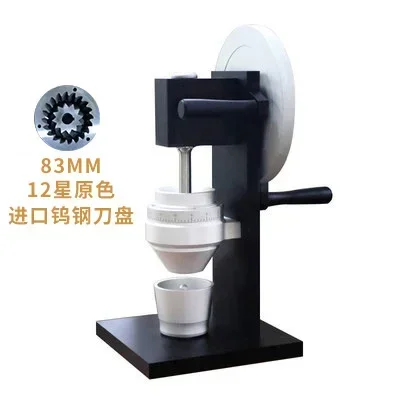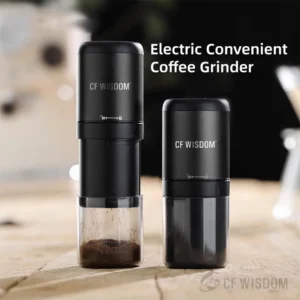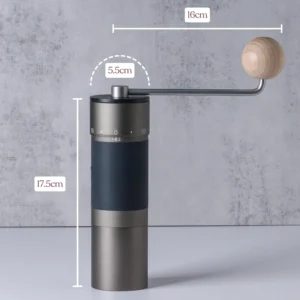Understanding Why Espresso Grounds Clump: The Science Behind Sticky Coffee
If you’ve ever prepared espresso at home, you’ve likely encountered a frustrating phenomenon: clumpy coffee grounds. These stubborn clusters can transform what should be a smooth, evenly packed puck into an uneven mess, ultimately affecting the quality of your espresso shot.
The consistency of your coffee grind directly impacts extraction quality. When grounds clump together, water finds the path of least resistance during brewing, flowing more quickly through some areas while barely penetrating others. This inconsistent extraction leads to espresso that’s simultaneously bitter and sour – a disappointing result for any coffee enthusiast.
But why exactly do espresso grounds clump together? Several key factors contribute to this common issue:
- Static electricity generated during the grinding process causes particles to attract each other
- Moisture and oils naturally present in coffee beans act as adhesives between particles
- Extremely fine grind size required for espresso increases surface contact between particles
- Grinding friction creates heat that can release oils and exacerbate clumping
These factors don’t operate in isolation – they work together in complex ways. For instance, static electricity becomes more pronounced in dry environments, while grinding creates heat that releases oils, which then contribute to clumping.
Understanding proper grind consistency is essential for quality espresso preparation. Unlike coarser grinds used for pour-over or French press, espresso’s fine texture makes it particularly susceptible to clumping issues.
Static Electricity: The Invisible Culprit
One of the primary culprits behind clumpy espresso grounds is static electricity. When coffee beans pass through your grinder, friction between the beans and grinder components generates an electrical charge. This process, known as the triboelectric effect, causes particles to become positively or negatively charged.
Once charged, these tiny coffee particles naturally attract each other – much like how a balloon rubbed on hair sticks to a wall. This attraction is especially strong with fine espresso grounds due to their increased surface area and lightweight nature.
Environmental factors significantly influence static electricity development:
- Low humidity environments (common in winter months or climate-controlled spaces) drastically increase static buildup
- Plastic components in grinders tend to generate more static than metal parts
- The extremely dry conditions of heated indoor spaces during winter months create the perfect environment for static-induced clumping
You may notice your grinder isn’t producing consistent results across different seasons or environments. This inconsistency often stems from varying static conditions affecting how grounds behave after grinding.
Moisture and Coffee Oils: Nature’s Adhesives
Beyond static electricity, natural components in coffee beans themselves contribute significantly to clumping. Coffee beans contain oils and moisture that release during grinding, essentially creating natural “glue” that binds particles together.
Several factors influence how much oil and moisture affect your grounds:
- Roast level: Darker roasts typically contain more surface oils than lighter roasts
- Bean freshness: Freshly roasted beans release more CO2 and volatile compounds
- Bean storage: Improperly stored beans may absorb excess moisture
- Environmental humidity: Higher humidity environments contribute additional moisture
The science behind this is straightforward – oils create surface tension between particles, while moisture facilitates hydrogen bonding. Together, they create significant adhesive forces between the tiny coffee particles.
Coffee bean oil content varies significantly based on roast level. Light roasts typically contain 10-12% oils that are mostly trapped inside the bean structure. Dark roasts can contain 15-17% oils with significantly more oils brought to the surface during the extended roasting process. This explains why different roasts require different grind approaches when preparing espresso.
Grind Size Matters: Why Espresso Is Particularly Prone to Clumping
Espresso requires exceptionally fine grounds – typically between 250-400 microns in size – which makes it especially susceptible to clumping. This isn’t merely coincidental but directly related to physics principles.
As particle size decreases:
* Surface area to volume ratio increases dramatically
* Particles become lighter and more easily influenced by static forces
* More contact points exist between individual particles
* Electrostatic and oil-based adhesion becomes more powerful
Compare this to the coarser grind used for French press (800-1000 microns) and it becomes clear why you rarely see clumping with those brewing methods. The relationship between surface area and clumping tendency is exponential – halving the particle size can quadruple the clumping potential.
Finding the perfect espresso grind size involves balancing extraction requirements with practical concerns about clumping. While extremely fine grounds might theoretically extract best, they also present the greatest challenge in terms of even distribution and flow resistance.
Equipment Factors: Is Your Grinder Contributing to the Problem?
The quality, design, and condition of your coffee grinder significantly impact clumping tendency. Not all grinders are created equal when it comes to producing consistent, clump-free espresso grounds.
Key equipment factors that contribute to clumping include:
- Grinder design and burr quality
- Heat generation during grinding
- Ground retention in the grinder path
- Anti-static features (or lack thereof)
- Burr alignment and condition
Professional café grinders typically incorporate features specifically designed to combat clumping – such as fluffier ground delivery systems, active cooling, and clump-crushing screens. Home grinders, particularly budget models, often lack these refinements.
Investing in quality manual espresso grinders can significantly reduce clumping issues. High-quality manual grinders often generate less heat and static than electric counterparts while providing exceptional grind consistency.
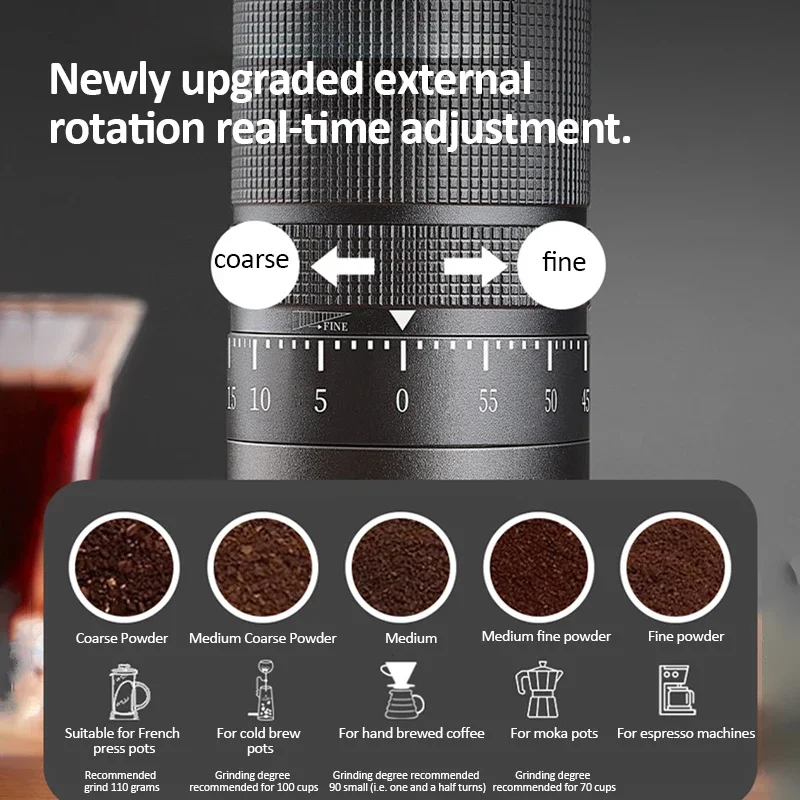
Heat Generation: When Your Grinder Gets Too Hot
Heat is a significant yet often overlooked contributor to espresso ground clumping. During grinding, friction between coffee beans and burrs can raise temperatures considerably – with some grinders experiencing temperature increases of 30°F (17°C) after just 30 seconds of continuous operation.
This heat acceleration affects your coffee in several problematic ways:
- Triggers the release of additional oils from within the bean structure
- Causes moisture to evaporate, creating micro-steam that condenses on cooler grounds
- Changes the physical properties of oils, making them more adhesive
- Can temporarily alter burr alignment through thermal expansion
Higher-quality grinders incorporate heat-dissipating features like aluminum heat sinks, larger mass burr carriers, or external cooling systems. Manual grinders naturally generate less heat than motorized options, providing an advantage for small batch espresso preparation.
Burr Condition and Alignment: The Foundation of Consistent Grinding
The condition and alignment of your grinder’s burrs fundamentally impact both grind consistency and clumping tendency. Properly maintained, sharp burrs create more uniform particles with cleaner edges, reducing the likelihood of interlocking and clumping.
Key burr-related factors include:
- Burr sharpness: Dull burrs crush rather than cut beans, creating more fines and irregular particles
- Alignment: Misaligned burrs produce inconsistent particle sizes
- Burr design: Conical burrs typically produce slightly more clumping than flat burrs due to particle shape
- Material quality: Higher-quality steel or ceramic burrs maintain sharpness longer
Most home grinder burrs maintain optimal performance for grinding approximately 500-1000 pounds (225-450 kg) of coffee beans before requiring replacement. Professional-grade burrs may last significantly longer.
For those seeking optimal performance, flat burr hand grinders often provide excellent consistency with minimal clumping, especially for espresso preparation.
Retention and Path Design: Where Grounds Get Stuck
How coffee moves through your grinder significantly affects clumping. Poorly designed grind paths can:
- Create areas where grounds accumulate and become stale
- Cause grounds to compact against surfaces, increasing clumping
- Generate additional static through excessive contact with non-conductive materials
- Restrict smooth flow, creating pressure points that compress grounds
Better-designed grinders feature:
* Smooth, direct grind paths minimizing retention
* Anti-static materials or treatments
* Declumping screens or mechanisms
* Minimal distance between burrs and grounds exit
The difference in retention between grinders is substantial. Entry-level grinders typically retain 1-2 grams (0.035-0.07 ounces) of coffee, while premium low-retention designs can reduce this to just 0.1-0.3 grams (0.004-0.01 ounces).
Practical Solutions: How to Combat Clumping
Fortunately, several effective techniques can help you overcome clumpy espresso grounds. These range from immediate fixes to long-term solutions addressing root causes.
Consider this the toolbox approach to clumping issues:
- Immediate post-grinding solutions (like WDT) address clumps that have already formed
- Preventative techniques (like RDT) stop clumps from forming in the first place
- Maintenance practices ensure your equipment performs optimally
- Grind adjustment strategies find the sweet spot between extraction and clumping
- Bean selection and storage methods set the foundation for success
Many professional baristas employ a combination of these techniques to ensure consistent, clump-free grounds. Home baristas can achieve similar results by systematically implementing these practices.
Choosing the right precision manual grinder can significantly reduce the need for extensive anti-clumping measures, as quality equipment addresses many causes at the source.
The WDT Method: Breaking Up Clumps After Grinding
The Weiss Distribution Technique (WDT) has become nearly universal among serious espresso enthusiasts for good reason – it works remarkably well. This method, pioneered by John Weiss on coffee forums in the early 2000s, involves gently stirring freshly ground coffee with thin needles to break up clumps and distribute grounds evenly.
To perform effective WDT:
- Grind your coffee directly into the portafilter or dosing cup
- Use a tool with 3-5 thin needles (0.3-0.4mm diameter)
- Insert the needles fully into the grounds
- Make slow, gentle stirring motions throughout the coffee bed
- Focus particularly on the edges and bottom of the basket
- Continue until the grounds appear fluffy and uniform
- Tap the portafilter gently to level the surface
- Tamp as usual
You can easily make your own WDT tool using acupuncture needles, straightened paper clips, or even fine gauge guitar strings mounted in a cork or wooden handle. Commercial WDT tools typically range from $15-45.
Proper WDT implementation typically improves extraction consistency by 2-4 seconds between shots and noticeably enhances flavor clarity. Understanding the principles of espresso grind consistency helps explain why this technique is so effective.

The RDT Method: Preventing Static Before Grinding
The Ross Droplet Technique (RDT) addresses static electricity before it becomes a problem. This preventative approach, developed by barista Ross Quail, involves adding a tiny amount of moisture to coffee beans before grinding.
To properly implement RDT:
- Measure your whole coffee beans as usual (e.g., 18 grams/0.6 ounces)
- Slightly dampen a spoon handle or clean finger
- Stir the beans very lightly with the damp implement
- Ensure beans appear barely moistened, not wet
- Proceed with grinding as normal
The key is using minimal moisture – just 2-4 drops of water per standard espresso dose. Too much water can damage grinders, particularly those with steel burrs susceptible to oxidation.
Scientific analysis indicates that RDT can reduce static-induced retention by 50-80% with minimal impact on extraction. The technique works by creating a microscopic conductive layer on bean surfaces that dissipates static charges during grinding.
Grinder Maintenance: Keeping Your Equipment in Top Shape
Regular maintenance dramatically reduces clumping issues while extending your grinder’s lifespan. A well-maintained grinder produces more consistent particles with less static buildup and fewer retained grounds.
Essential maintenance practices include:
- Daily cleaning:
- Brush out ground retention areas after each session
- Wipe down the exterior and grounds bin
Tap or brush the grinder chute to dislodge retained grounds
Weekly cleaning:
- Remove and clean the grounds bin thoroughly
- Use a vacuum to remove grounds from inaccessible areas
Clean the burr chamber entrance and exit
Monthly deep cleaning:
- Disassemble according to manufacturer instructions
- Clean burrs with a dedicated brush
- Use specialized grinder cleaning products like Grindz
- Check for burr wear and alignment issues
Specialized coffee grinder cleaning products effectively remove oil buildup without damage. Alternatives include food-safe compressed air or uncooked rice (though some manufacturers advise against rice due to hardness concerns).
Understanding coffee grinder maintenance requirements is essential for optimal performance and longevity. Regular maintenance prevents many clumping issues before they begin.
Grind Adjustment Strategies: Finding the Sweet Spot
Finding the optimal grind setting involves balancing extraction quality with practical considerations like clumping tendency. Often, minor adjustments can significantly reduce clumping without compromising flavor.
When adjusting your grind to reduce clumping:
- Start with your current setting that produces good flavor but clumpy grounds
- Make incremental adjustments slightly coarser (approximately ¼ turn)
- Prepare and taste test espresso after each adjustment
- Find the point where clumping diminishes but extraction remains acceptable
- Use distribution techniques to compensate for slightly coarser grounds
Be methodical – change only one variable at a time and document results. Many experienced baristas find that settings just slightly coarser than “maximum clumping” often provide optimal extraction when combined with proper distribution techniques.
Understanding how to properly adjust your grind for espresso helps navigate this delicate balance between extraction quality and workability.
Fine Adjustment Hand Grinder, Precision Manual Grinder, Travel Coffee Grinder
Price range: $185.11 through $494.63 Select options This product has multiple variants. The options may be chosen on the product pageHand Burr Grinder, Hand Crank Coffee Grinder, Manual Espresso Grinder, Portable Coffee Grinder
Price range: $262.72 through $300.22 Select options This product has multiple variants. The options may be chosen on the product pageHand Burr Grinder, Manual Coffee Grinder Stainless Steel, Precision Manual Grinder
Price range: $183.64 through $187.52 Select options This product has multiple variants. The options may be chosen on the product pageManual Coffee Grinder Stainless Steel, Manual Espresso Grinder, Travel Coffee Grinder
Price range: $276.22 through $276.39 Select options This product has multiple variants. The options may be chosen on the product pageHand Crank Coffee Grinder, Manual Coffee Grinder for Espresso, Manual Coffee Grinder Stainless Steel
$349.15 Select options This product has multiple variants. The options may be chosen on the product page
Bean Selection and Storage: Setting Yourself Up for Success
The coffee beans you select and how you store them significantly impact clumping tendency. Both factors affect moisture content and oil distribution – key contributors to clumpy grounds.
Consider these factors when selecting and storing beans:
- Freshness (days since roasting)
- Roast level (light, medium, or dark)
- Processing method (washed, natural, honey)
- Storage container (airtight, UV-protected)
- Environmental conditions (temperature, humidity)
Properly stored beans in appropriate containers maintain optimal moisture levels. Beans exposed to humidity fluctuations or stored in permeable containers may absorb excess moisture, exacerbating clumping issues during grinding.
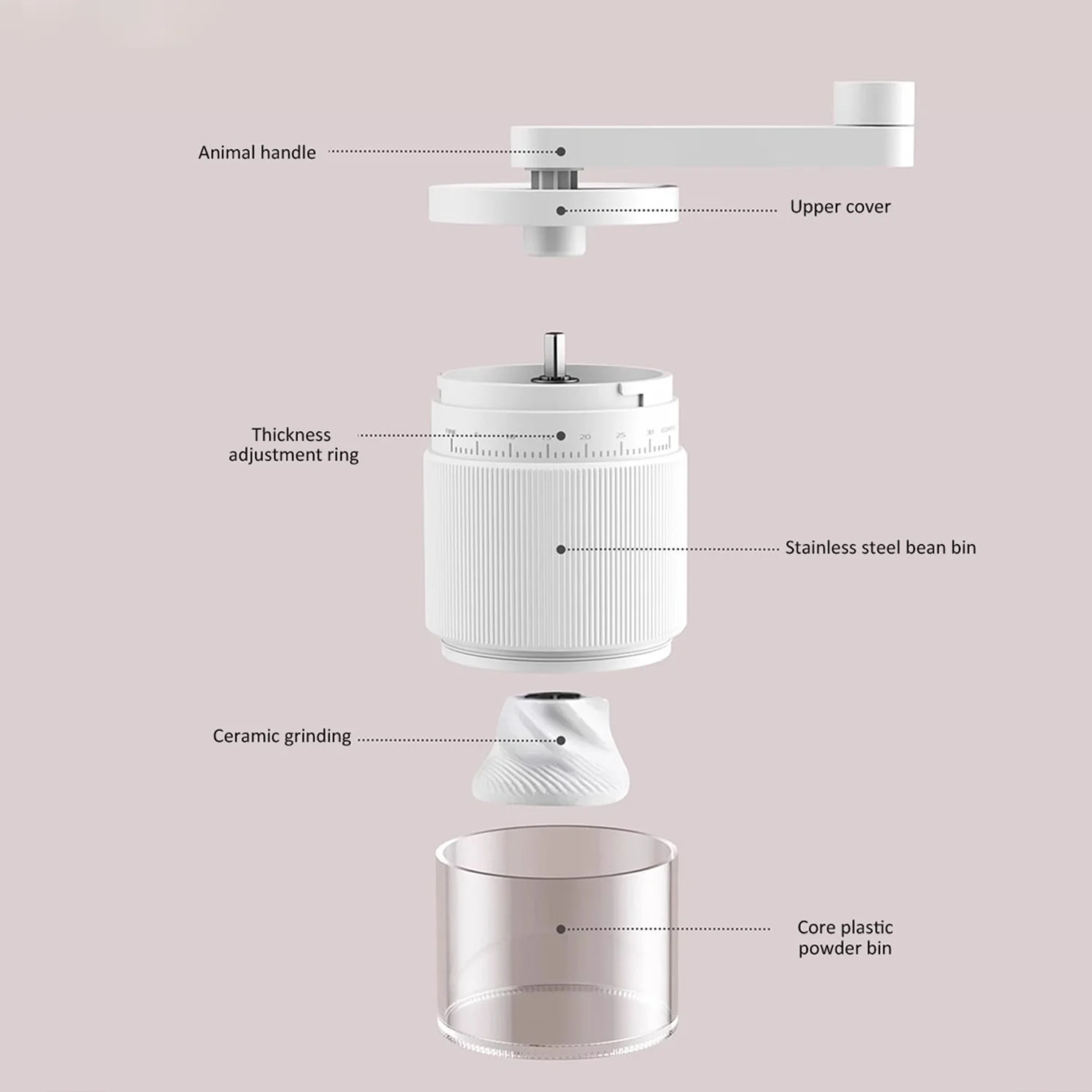
Bean Freshness: Finding the Optimal Window
Surprisingly, beans can be both too fresh and too stale for optimal espresso preparation. Very fresh beans (1-4 days post-roast) contain significant CO2 that releases during grinding and extraction, creating inconsistencies and often more pronounced clumping.
The ideal freshness window varies by roast level:
* Light roasts: 7-14 days post-roast
* Medium roasts: 5-12 days post-roast
* Dark roasts: 5-10 days post-roast
Beyond these windows, beans progressively lose volatile compounds and become drier, changing how they grind. While older beans might produce less clumping due to reduced oil content and CO2, they typically produce flat-tasting espresso lacking complexity and crema.
Storage Best Practices: Preserving Bean Quality
Proper coffee storage minimizes moisture fluctuations and preserves oils in their intended state:
- Optimal containers:
- Airtight canisters with one-way degassing valves
- Opaque or UV-filtering containers that block light
Containers sized appropriately for your consumption rate
Environmental factors:
- Store at 65-70°F (18-21°C)
- Maintain 40-60% relative humidity
- Avoid temperature fluctuations
Keep away from strong odors
Avoid:
- Refrigerator storage (creates condensation when removed)
- Clear glass containers (allow light degradation)
- Storing near heat sources or in direct sunlight
Single-dosing – measuring individual doses just before grinding – offers advantages for freshness and minimizing retention but may increase static compared to beans that have rested in a hopper.
For different bean types, having the right manual coffee grinder for espresso ensures you can make appropriate adjustments for each variety.
When to Consider a Grinder Upgrade
If you’ve implemented the techniques above but still struggle with persistent clumping issues, it may be time to consider upgrading your grinder. Grinder quality directly impacts clumping tendency, with higher-end models incorporating specific design elements to minimize this problem.
When evaluating potential upgrades, look for:
- Quality burr sets (precision-machined steel or ceramic)
- Effective anti-static measures
- Direct grind paths minimizing retention
- Stepless or micro-adjustment capabilities
- Reputation for consistent particle distribution
- Built-in declumping screens or mechanisms
Budget considerations are important, but remember that grinder quality impacts every cup you make. Entry-level espresso-capable grinders typically start around $200-300, while prosumer models range from $500-1500. Commercial-grade grinders can exceed $2000 but offer exceptional consistency.
For precision espresso preparation, consider exploring fine adjustment hand grinders that offer exceptional control over grind size with minimal clumping issues.
Is Some Clumping Actually Normal?
Many espresso enthusiasts pursue completely clump-free grounds, but is this realistic? The truth is that some minimal clumping is normal, especially with fresh, properly ground espresso coffee.
How to distinguish normal from problematic clumping:
Normal clumping:
* Small, easily broken clusters
* Distributes evenly with light tapping
* Consistent size throughout the dose
* Breaks apart readily during distribution
Problematic clumping:
* Large, dense clusters resembling wet sand
* Requires significant force to break apart
* Varies significantly throughout the dose
* Resists even distribution attempts
Even high-end commercial grinders costing thousands of dollars produce some clumping with certain beans. The goal isn’t necessarily eliminating all clumping but managing it effectively to ensure even extraction.
Can Humidity Changes Affect Your Grinder’s Performance?
Seasonal humidity fluctuations significantly impact grinder performance and clumping tendency. Many espresso enthusiasts notice their grinder settings and grounds behavior change throughout the year without any other variables changing.
During winter months, indoor heating systems typically reduce humidity to 20-30%, creating ideal conditions for static electricity generation. Summer months often bring humidity levels of 50-70%, reducing static but potentially increasing moisture-related clumping.
To accommodate seasonal changes:
* Winter: Implement RDT more frequently, consider a small humidifier near your coffee station
* Summer: Clean your grinder more frequently, ensure beans remain properly stored
The popular myth of grinding in a steamy bathroom actually contains a kernel of truth – higher humidity does reduce static-related clumping. However, excessive humidity introduces its own problems and can damage both beans and equipment.
Does Clumping Always Lead to Bad Espresso?
While clumping certainly can lead to extraction problems, the relationship isn’t always straightforward. With proper distribution techniques, even moderately clumpy grounds can produce excellent espresso.
Signs that clumping is negatively affecting your extraction:
* Visibly uneven extraction when using a bottomless portafilter
* “Channeling” with streams of pale, fast-flowing liquid
* Significantly inconsistent shot times between identical preparations
* Sour and bitter flavors simultaneously present
Professional cafés often use grinders that produce some clumping but implement systematic distribution techniques to ensure consistency. The key isn’t eliminating clumps entirely but ensuring they don’t lead to channeling or uneven extraction.
With practice and attention to the techniques described above, you can achieve consistently excellent espresso regardless of whether your grinder produces some clumping. The most important factor is developing a systematic approach that addresses your specific equipment characteristics.
At Savor Suite, we understand the frustrations of clumpy espresso grounds. That’s why we carefully curate our selection of premium manual grinders to help you achieve the perfect espresso grind – and the perfect extraction that follows.

